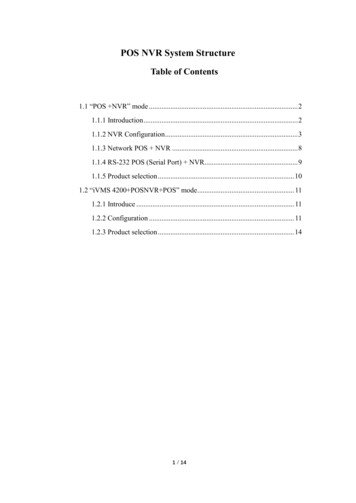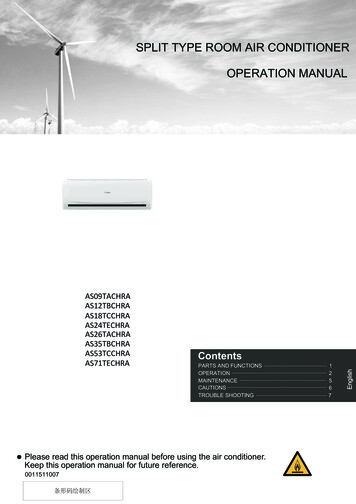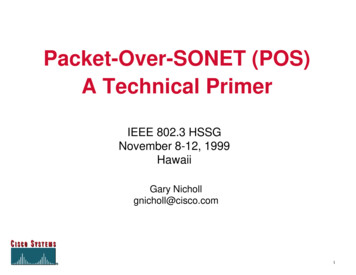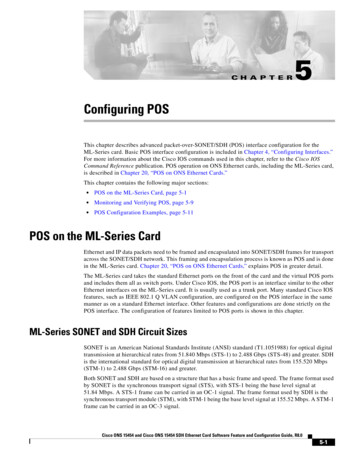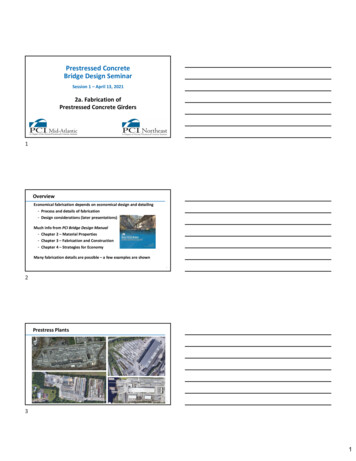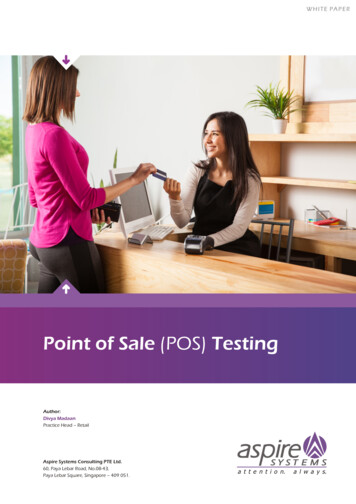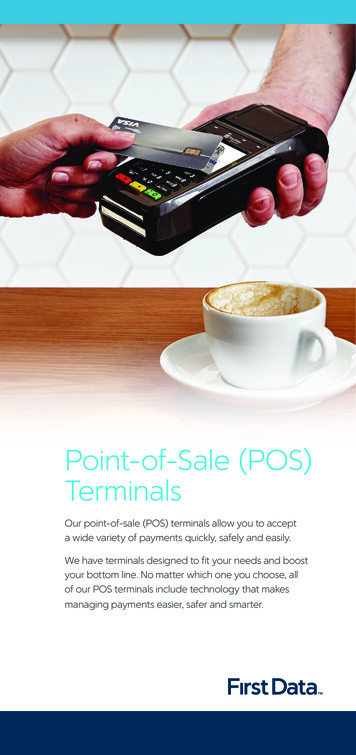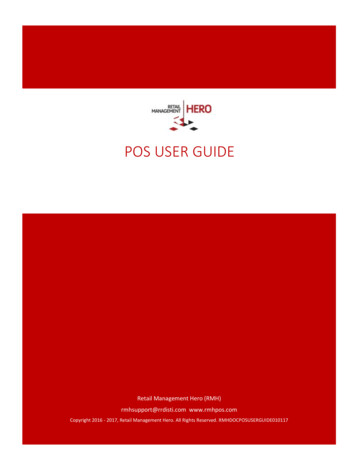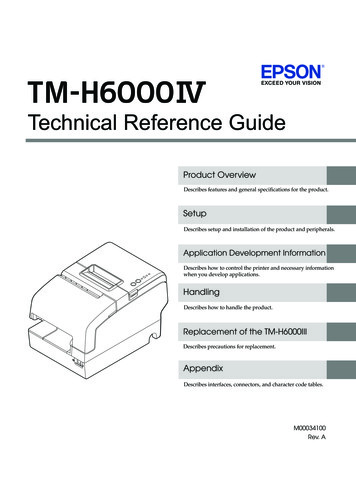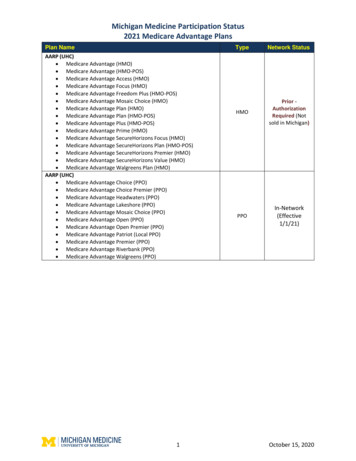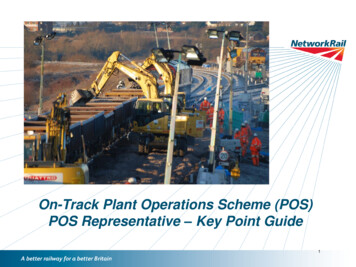
Transcription
On-Track Plant Operations Scheme (POS)POS Representative – Key Point Guide1
ScopeThe purpose of the On-Track Plant Operations Scheme (POS) is to define thecompulsory requirements and minimum means of compliance for an organisationundertaking the provision and operation of On-Track Plant (OTP). The scope of the POSextends to all organisations carrying out OTP operations on Network Rail ManagedInfrastructure (NRMI) and Network Rail projects.The Scheme applies to all OTP as defined in Network Rail Standard NR/L2/RMVP/0200 – Infrastructure Plant Manual (IPM). OTP must meet the requirements ofRail Industry Standard RIS-1530-PLT Rail industry standard for engineeringacceptance of on-track plant and associated equipment. OTP includes Rail MountedMaintenance Machines (RMMM), Road-Rail Vehicles (RRV), trailers and attachments.Plant operations using non-OTP are not in the scope of the POS unless working on ornear the line, i.e. within 3 metres, on a POS controlled site. The IPM covers the detailsregarding non-OTP, however, it is a pre-requisite that a POS provider has adequatearrangements in place for the provision and use of non-rail mounted plant, similar to thearrangements they apply to OTP.2
Examples of types of On-Track PlantRail Mounted Maintenance Machine(RMMM)Materials Handler (MH)Mobile Elevated Work Platform(MEWP)Crawler Tractor (Dozer)Highway Permissable Vehicle (HPV)Please note this list is notexhaustive, there aremany other types of plantand machinery where thePOS will apply. If you areunsure please submityour enquiry to the POSReview Panel at:POS@networkrail.co.uk3
BackgroundEffective site control is a major factorin achieving site safety compliance.As part of the POS requirements there mustbe a competent representative on sitewhenever OTP operations are taking place.This role is known as the POSRepresentative, who must be an employee ofthe POS provider and be competent indelivering the POS providers arrangementsfor safe plant operations.This presentation highlights specific areas ofplanning, plant usage, key responsibilitiesand general plant awareness to assist andsupport the POS Representative incontributing to safe plant operations.4
Key Principles(ALSO a requirement of the PDSW Programme) Effective local planning – ‘those who do the work are involved in planning the work’ One single accountable mind for OTP operations Process developed by those who use it Live risk management of OTP risks at the point of work Independent monitoring and checking of controls at the point of work Same process for NR and contractor communities5
When Things go wrongWhen plant operations are not effectively planned or controlled seriousaccidents/incidents can occur.This construction site 360 crawlerexcavator illustrates just how easilythis can happen and this is before wethink about putting rail wheels on it!!!Incorrect and dangerouscross tracking due to poorplanning of the work.6
The Lifesaving entre/Lifesaving-Rules7
POL Vs POSRail Plant Operating in Possessions Licence (POL) The site management and control of OTP in possessions is onlypermitted by a corporate operator holding a Rail Plant OperatingCompany in Possessions Licence (POL)” POL applies to Network Rail and it’s contractors Must have an adequate management system Have a suitable Competence Management System Have adequate processes in place The Plant Operator Licence holder shall demonstrate theirunderstanding of the roles and responsibilities of the PrincipalContractor in relation to the Plant Operator Licence holder. The Plant Operator Licence holder is required to have in place:Representation on site, by an individual competent in On TrackPlant operations. This individual will be the single point ofcontact on site in respect of communications with the PrincipalContractor The Plant Operator Licence Holder shall have in place: a) arepresentative acting as the single point of contact during thecourse of the On Track Plant activities b) accident / incidentreporting arrangements that are consistent with the PrincipalContractors arrangements c) emergency planning / contingencyplanning arrangements that are consistent with the PrincipalContractors arrangements Have adequate insurance coverNR/L3/INI/CP0073 (Withdrawn 2014) – Supplier Licensing RequirementsOn-Track Plant Operations Scheme (POS) The site management and control of OTP is only permitted byan approved On-Track Plant Operations Scheme provider(POS) POS applies to Network Rail and it’s contractors Must have an adequate management system Have a suitable Competence Management System Have adequate processes in place The POS provider shall demonstrate their understanding of theroles and responsibilities of the Principal Contractor in relationto the POS. The POS provider is required to have in place representation onsite, by an individual(s) competent in OTP operations. POS representatives must be employees of the POS providerand must not carry out any other concurrent safety critical dutieson site. The POS provider must be an owner of operational OTP The POS provider must have in place accident / incidentreporting arrangements and emergency planning / contingencyplanning arrangements that are consistent with the PrincipalContractors arrangements Have adequate insurance coverNR/L2/RMVP/0200/Module P521 - Infrastructure Plant Manual8
The On-Track PlantOperations Scheme (POS)9
The Ten POS Rules (Module P521)OTP operations on NRMI and Network Rail projects shall be carried out by an approved POS provider. POSproviders are approved by the POS review panel, to gain approval a POS provider shall demonstrate to the POSreview panel that they have:1. a fully documented management system and framework for the safe delivery of OTP operations;2. a competence management system for assuring the competence and fitness of their employees and contractedstaff involved in the operation, maintenance and supervision of OTP operations in accordance with the Sentinelscheme rules;3. adequate processes to enable effective communication and co-ordination within all worksites;4. an adequate number of POS representatives present on each site to act as the point of contact. POSrepresentative shall be employees of the POS provider and not be engaged in any other concurrent safety criticalduties on site;5. arrangements in place for the proactive and reactive monitoring of their own performance and that of theirsuppliers;6. arrangements in place to respond to emergencies while undertaking OTP operations;7. title of ownership of operational OTP and have adequate and fully documented processes in place for theapproval, acceptance, operation and maintenance of their OTP;8. adequate arrangements in place for the selection and use of suitable suppliers, including safety critical goods,products or services. Suppliers used to provide OTP shall be Network Rail approved through the RailwayIndustry Supplier Qualification Scheme (RISQS).;9. adequate arrangements for the operational control, preparation, development, communication andimplementation of the safe system of work for OTP operations;10. identified and maintained information relating to the scope of the OTP operations they undertake.10
POS Representative – Key Points1. Planning2. Site Communication3. On / Off / Cross Tracking Arrangements4. Machine Controller Interface5. Crane Controller Interface6. Riding on Vehicles7. Site Conditions8. Working next to Any Lines Open (ALO)9. Person – Plant Interface (exclusion zones)10. OTP Attachments/Lifting Equipment11. OTP Emergency Arrangements12. If Things go Wrong11
1. POS Representative - Planning Key PointsAll work shall be planned to identify hazards, assess risks, and prepare a safe system of workfor OTP operations.POS Representatives MUST: Be involved in, and assist with the planning of OTP operations and the documenting of these inthe OTP Plan. Have access to appropriate and competent resourcesin relation to OTP operations including lift planning andany line open (ALO) working. Assess information on risks that are provided by the PC,Network Rail and from the POS provider’s own site walk out,and that the necessary information is provided forincorporation into the OTP Plan. Make sure that essential communication andliaison between all those involved in the work takesplace as planned.12
1. POS Representative - Planning Key PointsPOS Representatives must consider the following when planning work with OTP: Description of work to be undertaken and the use that will be made of the plant. Safe system for operations affecting any any line open (ALO), overhead line equipment (OLE) orthird and fourth rail areas including third party owned OLE. Limitations and obstructions to space and clearance such as gauge restrictions, bridges, platforms,buried cables and troughing etc. Identification and suitability of road-rail access points (RRAP) for on/off/cross tracking of OTP. The transportation of OTP to/from the site access point Worksite details and the movements involved, including to/from the worksite. Details of where different modes of operation are to be undertaken. Site briefing arrangements and responsibilities Emergency information and emergency plan, including contacts and recovery arrangements. Storage/stabling locations including security requirements on site. Communications including Duplex communications equipment. Cooperate and coordinate with the PC on traffic management planning, to includerequired exclusion zones and safe movement of personnel and OTP from the delivery point andthroughout the site. Contingency planning arrangements in place for preventing the operation of defective OTPperforming a safety critical function.13
2. POS Representative - Site Communication Key PointsIn the many of the accidents and incidents investigated poor communications was identified as acontributory cause. It is therefore essential that effective communication is implemented to support safeOTP operations. The OTP briefing should detail the preferred method of communication for controllingOTP on site.Before work you must: confirm site communication for the control of OTP is stated in the OTP briefing. confirm that Duplex communication systems are available and ready for use. establish that staff that are using Duplex communication systems on site have been instructed intheir use.During work you must: observe whether the MC/CC during OTP operations has established the correct communicationmethod. observe if the MC/CC (while communicating with the operator) is standing in a safe position. observe if the MC/CC (if using hand signals) is displaying the correct hand signals. speak to the MC/CC/machine operator to establish that the communication method adopted onsite is working effectively.14
3. POS Representative - OTP Access Key PointsOn/off/cross tracking of OTP should be carried out using approved Road Rail Access Points (RRAPs).This activity should be pre-planned and identified within the site documentation. The RRAP locationsand details should be included within the OTP Plan and OTP briefing documents (e.g. ‘Work PackagePlan’ and ‘Task Brief’)Before work you must: confirm that the MC/CC has checked the Engineering Acceptance Certificate (EAC) forlimitations of use prior to on/off tracking or operating the OTP. advise the ES/PIC/SWL before they give authority to an MC/CC to on-track the machine, toconfirm that the RRAP location is as stated in the OTP Plan and is suitable for the machine. confirm whether cross tracking has been identified in the site documentation, and if so speakwith the ES/PIC/SWL to establish what has been provided to ensure it is carried out correctly. identify whether suitable lighting has been provided at the RRAP.During work you must: check the level of lighting at the RRAP is adequate (during hours of darkness). establish that the RRAP being used is adequate and in usable condition . ensure that any cross tracking is carried out using approved systems/methods advise the ES/PIC/SWL and MC/CC on machine access arrangements or concerns. inspect the track at the RRAP before handing back the track.15
4. POS Representative - Machine Controller interface (MC)Key PointsA POS Representative is responsible for implementing controls to maintain sitesafety during OTP operations. The OTP Brief provided to the MC should detail thetype of OTP and the specific work which is to be undertaken.Before work you must: confirm prior to starting work that the OTP is as stated in the OTP Brief identify if a MC is to control more than one OTP (if they are it should bedocumented the brief) remind site staff during your brief to obey any instructions given to themby the MC relating to OTP operations. establish the MC has completed the MC/CC checklist.During work you must: observe the MC during OTP operations (especially people - plantinterface). observe if the MC has set up effective communication with the operator. speak to the MC and establish all machine checks/documentation havebeen carried out and are correct. establish when the MC is to move the OTP over points/level crossing askhim to describe the arrangements he would follow. ask the MC does he have any concerns about OTP operations on this site.Is the MC aware ofany O/H restrictionson site?Level Crossing16
5. POS Representative - Crane Controller InterfaceKey PointsIt is essential that an accurate lift plan has been produced for all lifting activities. The CCmust fully understand the information contained in the plan prior to starting any liftingoperations. Any changes to the lift plan must be recorded.Prior to starting work to: establish that the CC is in receipt of the lift plan and understands the specificlifting operations which are to be carried out on site. remind the CC not to undertake any lifting activities that are not included in thelift plan, until the lift plan has been amended for that activity and it is safe toundertake. remind the CC that the RCI must remain switched on during lifting operations. establish the CC has completed the MC/CC checklist.During the works: observe during lifting that CC and other site personnel are in a position ofsafety. observe if the effective communication has been set up between CC andoperator. observe during lifting that the RCI is switched on – if not on then lifting operationmust be stopped immediately.17
6. POS Representative - Specific OTP Rules Key PointsRiding on OTP or VehiclesYou must not ride, or let anyone else ride, on the OTP or any vehicle attached to it unlessthere is purpose-made seating or a riding platform and its use is authorised in theEngineering Acceptance Certificate (EAC). Situations have occurred in the past whenMC/CC have travelled on machines where no seat was available. This had occurred whenthe machine had to travel more than a short distance to the place of work.When on site: Check whether the EAC permits persons totravel on the machine. A copy of the EACmust be carried on the machine as part ofthe machine documentation. Remind MC/CC/MO during siteconversations of the importance of this rule. Observe during OTP movements(especially where the OTP is travellingmore than a short distance) that this rule isbeing followed.Example of a machine with an additional seat for the MC18
7. POS Representative – Site Conditions Key PointsMany accidents have occurred during OTP operations when poor rail head conditions have beenpresent. Where these conditions have been identified it is important to take precautions to avoid anyaccidents, collisions or SPADs. These conditions can be made worse if on a steep gradient – extrabraking distance will be required. Speed is another factor which must be taken into account – OTPshould only travel at the speed which is suitable for the site conditions/operations and at a speed whichallows the OTP to stop immediately when required.Before work you must: Remind staff involved in OTP operations the importance of increasing the overall brakingdistance of the machine if poor rail head conditions are present. Remind the operator (s) where there is a possibility of poor rail head conditions to lightlyapply the brake shortly after setting off and regularly during the journey to check adequaterail adhesion. Remind staff involved in OTP operations of any steep gradients on site – these must betaken into account at planning stage when determining the braking distances required tostop the OTP.During work you must: Assess whether poor rail head conditions have become present on site. Observe during OTP operations that sufficient braking distances are being applied. Observe any changes in site conditions that could introduce poor rail head conditions. Advise the MC/CC/MO on any concerns they may have relating to poor rail headconditions.19
8. POS Representative - OTP Working next to any linesopen (ALO) Key PointsIt is important before working next to ALO to review the planned method of working to confirm thatthe system is suitable for the location and the work being undertaken.Before work you must: before on/off tracking or working, check whether the machine EAC permits usageunder ALO conditions. establish that the ALO working method is detailed in the site documentation and issuitable for that location. speak to the site staff involved in setting up and implementing the system to establish ifthey fully understand the process which is to be adopted on site.During the work you must: observe the ALO working method to establish it has been implemented correctly. observe that the OTP only starts to work when the person in charge of the method ofworking has gave permission to do so. Advise the MC/CC/MO on any concerns they may have relating to the method of ALOworking. Monitor the work and manage any changes to the plan if necessary20
9. Plant – Person Interface Key PointsGeneralAppropriate exclusion zones around the machinemust be set up by the MC/CC for their safety andthat of other site personnel.The MC/CC and all other staff working adjacent tothe machine must remain in view of the operatorwhen the vehicle is moving or operating.All staff working in the vicinity of OTP must be briefedof the limits of operation and any movements takingplace by the COSS or SWL in charge of safe systemof work.Person is notin operatorsarea of visionThe following illustrations are typical examples of thedanger zones that need to be controlled by theMC/CC.Remember – if you cannot see the operator clearlyhe cannot see you.21
9. Plant – Person Interface Key PointsBlind Area – The operator is unableto see obstructions and personnel inthis area.Blind AreaBlind AreaArea of vision –The operatoris able to see obstructionsand personnel in this areabut not the whole area at anyone time.Note - All of these areas move as the machinesuperstructure slews.Entrapment Area – Depending on thedesign of the machine there is a risk ofpersonnel entrapment between the rear ofthe machine superstructure and any fixedstructures.22
9. POS Representative - Plant/Person InterfaceKey PointsExclusion zones around plant must be included within the OTP plan (e.g. the ‘Control ofActivities Risk Section’ of the ‘Work Package Plan’ and ‘Task Brief’)Before work you must check staff have been briefed on: the dangers of working near or around plant. the reason for exclusion zones. not to enter an exclusion zone unless authorised and it is safe to do so. To always comply with site instructions relating to OTP movements.During work you must: observe and establish the effectiveness of the exclusion zones. establish if the MC/CC is in a position of safety when working with the OTP. observe whether the MC/CC has set up effective communication with theMachine Operator (MO). observe if any other site staff are in, or encroaching on, an area where they couldbe endangered by OTP movements – if they are move them to a place of safetyand review/advise them on their safe system of work.23
10. POS Representative - OTP Attachments Key PointsAll attachments that are to be used on site, must be planned in advance, included in sitedocumentation, suitable for the activity and inspected prior to use.Before work you must check staff have been briefed on: the dangers of working near and around plant when attachments are being used. the need to maintain exclusion zones during activities with specific attachments. the need to check that all attachments are in their inspection date prior to being used onsite. not to use an attachment unless it is correct for that particular task. the importance of reporting defective attachments. During work you must: observe that the correct attachment is used for the correct activity, if the attachment isincorrect for the activity ask the MC/CC to stop and review task operation. observe any attachments that are not being used are located in a safe area. speak to the MC/CC to see if they have any concerns over the attachments being used. 24
11. POS Representative - OTP Emergency ArrangementsKey PointsEmergency situations may develop on site at any time which, could endanger site staff and trains.Poor site communications and disregarding rules can lead to these situations occurring. Thesesituations can be made worse if the correct emergency arrangements are not “understood andimplemented”.Before work you must: establish that the planned emergency arrangements are documented and available on site.establish that the emergency arrangements/contacts are included in OTP Briefing.establish that the documentation clearly describes the site location/site of work (this isparticularly important if there is a need to call on the emergency services to attend site).establish if emergency equipment is available.Establish the arrangements for machine repair/recovery in case of machine failure orbreakdown.During work, you must: speak to the MC/CC/MO and confirm that the emergency (protection) equipment isavailable either with the OTP or with the MC/CC.ask the MC/CC to describe the arrangements he would follow if the OTP failed and fouledan open adjacent line.ask the MC/CC is he satisfied with the emergency arrangements as stated in the OTP Brief25
12. If Things Go Wrong Key PointsYou must always follow the planned procedures when things go wrong. Things to think about: Take the necessary measures to protect the line as a matter of priority. Contact emergency services (if required) and inform the relevant Control Centre. Be sure to provide asmuch information as you can concerning the incident. Remember: Who, What, When, Where, andWhy! If plant or equipment is involved and been the cause of an incident, injury or worse, give details of theplant type, fleet number, and owner. Also ensure that the plant item is quarantined on site pendinginvestigation or Control has advised of any other arrangements that have been made. Where lift plans do not cover the items to be lifted, ensure that the lift plan is only amended by acompetent Lift Planner. A Lift Planner may be on site, but if not, then make arrangements for the On-Call Lift Planner to agreeand sign off any proposed changes. If plant breaks down, arrange for the on-call fitter to attend should the MO not be able to safely repairthe item. If there is a fuel or hydraulic oil spillage, ensure the machine is switched off, and ensure that the spillkits are used to mop up or contain the spillage. Contact control, and give your best estimate of thequantity of fuel or oil spilled. You must inform the PC’s site representative of your actions.26
SummaryThe previous slides have highlighted some of the dangers when working with plant andsummarised the specific responsibilities of personnel who control OTP operations.These slides have been developed to assist you in your role as POS Provider or POSRepresentative when OTP operations are taking place.REMEMBEREFFECTIVE CONTROL SITE COMPLIANCE SAFE SITE 27
Further InformationIf you wish to provide feedback on this presentation or require further information onPOS please use the contact details workrail.co.uk28
OTP operations on NRMI and Network Rail projects shall be carried out by an approved POS provider. POS providers are approved by the POS review panel, to gain approval a POS provider shall demonstrate to the POS review panel that they have: 1. a fully documented management system and framework for the safe delivery of OTP operations;
